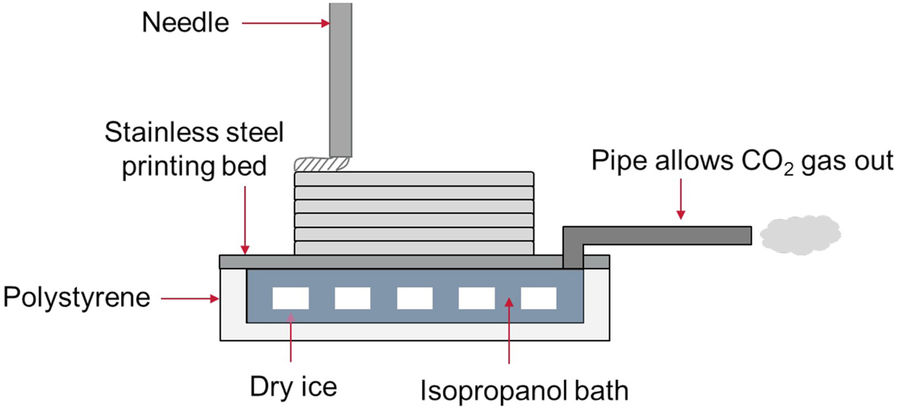The main challenge of synthetic tissue is fabricating it in a way that tricks the body into believing that it has been there all along. As a recent preprint from Stanford University shows, even CRISPR gene editing isn’t entirely safe from the body’s immune system, though many other regenerative medicine therapies have already been tried and tested to positive effect.
At Imperial College London, a method combining 3D printing and cryogenics may have the answer to replicating the texture of soft tissues in the body, and potentially fooling parts of our lungs and brain.
A hydrogel popsicle
The Imperial College method takes advantage of the liquid to solid phase change of a composite hydrogel ink. An Ultimaker 2 is modified to deposit the ink. It requires a setup that suspends a stainless steel print bed over a bath of dry ice and isopropanol (a secondary alcohol and common ingredient of antiseptics, disinfectants and detergents).

Upon contact with the bed, the ink solidifies. “This is achieved by rapidly cooling the ink solution below its freezing point using solid carbon dioxide (CO2) in an isopropanol bath,” explain Imperial’s researchers.
“The setup was able to successfully create 3D complex geometrical structures, with an average compressive stiffness of O(1) kPa (0.49 ± 0.04 kPa stress at 30% compressive strain) and therefore mimics the mechanical properties of the softest tissues found in the human body (e.g. brain and lung).”
Previously cryogenically 3D printed would typically disintegrate in use. But now, the researchers were able to apply living cell samples to the 3D printed scaffolds.

Cell survivors
The soft 3D printed scaffolds were successfully seeded with live dermal fibroblast cells. An ability to attach and survive on the hydrogel (when coated with collagen) shows great potential for the range of cryogenically 3D printed inks.
Though the current scaffolds are only a few centimeters in size, they provide a promising foundation to build towards a full organ. As detailed in the supporting study, this method broadens the scope of application “from soft tissue phantoms for surgical training and simulations to mechanobiology and tissue engineering.”
‘Cryogenic 3D Printing of Super Soft Hydrogels’ is available to read online in Scientific Reports journal. It is co-authored by Zhengchu Tan, Cristian Parisi, Lucy Di Silvio, Daniele Dini and Antonio Elia Forte.
Nominate the best research teams of 2017 in the second annual 3D Printing Industry Awards here.
Subscribe to the 3D Printing Industry newsletter, follow us on Twitter, and like us on Facebook here.
Featured image shows the structure of Imperial College London’s cryogenically 3D printed cell scaffolds. Image via Scientific Reports.


